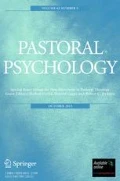Abstract
This paper acquaints one with and examines critically the reality of religious addiction. It describes some of the defining characteristics and symptoms. Rigidity, black and white thinking, low self-esteem, magical thinking, judgmental attitudes are but a few of the symptoms of this complex phenomenon described by myself as destructive soul work. The religious addict seeks to avoid pain and overcome shame by becoming involved in a belief system which offers security through its rigidity and its absolute values. This paper is not definitive in its scope. It's purpose is to explore and examine with the goal of gaining insight and awareness into the topic of religious addiction.
Similar content being viewed by others
REFERENCES
Arterburn, S., & Felton, J. (1991). Toxic faith. Nashville: Oliver-Nelson Books.
Batson, C. D. & Raynor-Prince, L. (1981). Religious orientation and complexity of thought about existential concerns. Unpublished manuscript. University of Kansas.
Batson, C. D & Ventis, W. L. (1982). The religious experience. New York: Oxford University Press.
Baugh, J. (1990). Recovering from addiction. New York: Insight Books.
Blue, K. (1993). Healing spiritual abuse. Illinois: Intervarsity Press.
Booth, Father L. (1991). When God becomes a drug. Los Angeles: Jeremy P. Tarcher, Inc.
Carr, A. E. (1988). Transforming grace. San Francisco: Harper and Row.
Chen, L-C. (1997). Grief as a transcendent function and teacher of spiritual growth. Pastoral Psychology 46(2), 79–84.
Festinger, L., Riechen, H. W., & Schacter, S. (1956). When prophecy fails. Minneapolis: University of Minnesota Press.
Fox, M. (1983). Original blessing. Santa Fe: Bear and Co.
Fox, M. (1991). Creation spirituality. San Francisco: Harper.
Fox, M., & Sheldrake, R. (1996). Natural grace. Toronto: Doubleday.
Helminiak, D. (1997). Killing for God's sake: The spiritual crisis in religion and society. Pastoral Psychology 45(5), 365–374.
Jeffers, S. (1993). The journey from lost to found. New York: Fawcett Columbine Books.
Jones, J. W. (1980). Macro-micro: “toward a systematic model of personality,” Journal of Religion and Health 75, 278–290.
Jones, J. W. (1991). Contemporary psychoanalysis and religion. New York: Brunner/Mazel.
Jones, J. W. (1995). In the middle of this road we call our life. San Francisco: Harper Collins.
Kennedy, E. C. (1971). In the spirit, in the flesh. New York: Doubleday.
Kiesler, C. A. (1971). The psychology of commitment: experiments linking behaviour to belief. New York: Academic.
Linn, D., Linn, S. F., & Linn, M. (1993). Belonging: bonds of healing and recovery. Mahwah: Paulist Press.
Linn, D., Linn, S. F., & Linn, M. (1994a). Good goats-healing our image of God. Mahwah, New Jersey: Paulist Press.
Linn, M., Linn, S. F., & Linn, D. (1994b). Healing spiritual abuse and religious addiction. Mahwah, New Jersey: Paulist Press.
May, G. G. (1988). Addiction and grace. San Francisco: Harper and Row.
Nakken, C. (1988). The addictive personality. San Francisco: Harper and Row.
Plante, T. G., & Boccaccini, M. T. (1997). The Santa Clara strength of religious faith questionnaire. Pastoral Psychology 45(5), 375–387.
Ritter, K. & O'Neill, C. (1996). Righteous religion. New York: The Haworth Pastoral Press.
Satir, V., Banmen, J., Gerber, J., & Gomori, M. (1991). The Satir Model. Palo Alto, California: Science and Behavior Books, Inc.
Schaef, A.W. (1990) “My journey to understanding addiction” presentation at the Fishnet Northeast Conference on “Recovering intimacy and the good news of the gospel.”
Schaef, A. W., & Fassel, D. (1988). The addictive organization. San Francisco: Harper and Row.
Seeburger, F. F. (1995). Addiction and responsibility. New York: Crossroad.
Westley, D. (1994). Redemptive intimacy. Mystic, CT.: Twenty-Third Publications.
Woodman, M. (1982). Addiction to perfection. Toronto: Inner City Books.
Author information
Authors and Affiliations
Additional information
private practice in
Rights and permissions
About this article
Cite this article
Vanderheyden, P.A. Religious Addiction: The Subtle Destruction of the Soul. Pastoral Psychology 47, 293–302 (1999). https://doi.org/10.1023/A:1021351428976
Issue Date:
DOI: https://doi.org/10.1023/A:1021351428976




